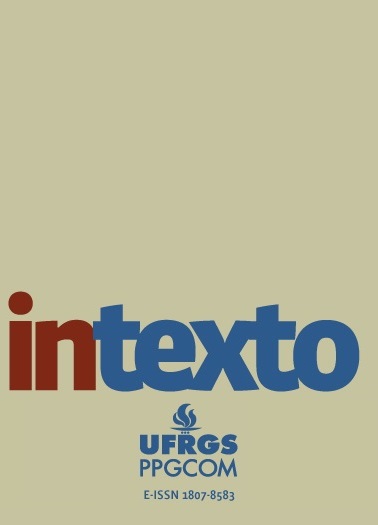The semiotics of drive images in the film Black Swan (2010)
DOI:
https://doi.org/10.19132/1807-8583202152.109455Keywords:
Cinema. Drive Image. Semiotics. Firstness. Secondness.Abstract
This paper aims to analyze by the theoretical perspective of Charles Sanders Peirce the constitution of the drive images in the film Black Swan (2010), directed by Darren Aronofsky. To this finality, we understand that the drive image, a type of movement image created and developed by Gilles Deleuze, is formed by the original world and the derived environment, which can be entropic and/or cyclical. It is the drives of the good and evil, embodied in the figures of the white swan and the black swan, that permeate Aronofsky's feature film. Thus, through the analysis of scenes and frames, we approach how the manifestation and functioning of these drive images occurs through the semiotic prism. We conclude, corroborating Deleuze's hypothesis, that the drive image is caught between an affection image and an action image because this cinematographic sign does not necessarily constitute an icon or an index, but occupies a space allocated in the vacuum between both, establishing, in this way, a constant sensation, understood in the threshold between a phenomenon of firstness and another of secondness.
Downloads
References
ASSIS, Machado de. Contos escolhidos. São Paulo: Martin Claret, 2012.
BELLOUR, Raymond. Pensar, contar: o cinema de Gilles Deleuze. In: RAMOS, Fernão (org.). Teoria contemporânea do cinema, volume I. São Paulo: Editora Senac-SP, 2005. p. 233-252.
CARVALHO, Cíntia Paula Andrade de; VIEIRA, Nancy Rita Ferreira. A metamorfose do cisne: do ciclo da “noiva animal” ao mito do duplo. Revista Vozes dos Vales da UFVJM, Diamantina-MG, v. 1, n. 2, p. 01-15, out. 2012.
CISNE negro. Direção: Darren Aronofsky. Produção: Scott Franklin, Arnold Messer e Brian Oliver. Intérpretes: Barbara Hershey, Jamie Wolf, Mila Kunis, Natalie Portman, Vincent Cassel e Winona Ryder. Roteiro: Andres Heinz, John McLaughlin e Mark Heyman. Estados Unidos: Fox, 2010. 1 DVD (108 min.), son., color.
DELEUZE, Gilles. A imagem-movimento: cinema I. Tradução Rafael Godinho. Lisboa: Assírio & Alvim, 2004. Obra original de 1983.
DELEUZE, Gilles. A imagem-tempo: cinema II. Tradução Eloisa de Araújo Ribeiro. São Paulo: Brasiliense, 2007. Obra original de 1985.
DOSTOIEVSKI, Fiódor. O duplo. Tradução Paulo Bezerra. São Paulo: Editora 34, 2013.
FREUD, Sigmund. A interpretação dos sonhos. Rio de Janeiro: Imago, 1999.
LAGO DOS CISNES. Compositor: Piotr Ilitch Tchaikovski. Coreógrafos: Vladimir Begitchev e Vasily Geltzer. Regente: Stepan Ryabov. Moscou, Teatro Bolshoi, 1877.
LEITES, Bruno. Imagens-pulsão: incidência e pertinência para compreender o cinema brasileiro dos anos 2000. Revista Científica/FAP, Curitiba, v. 12, p. 127-154, jan./jun. 2015.
LEITES, Bruno. O naturalismo e suas dispersões em filmes brasileiros dos anos 2000. Intexto, Porto Alegre, UFRGS. n. 49, p. 173-195, mai./ago. 2020.
LUZ, Ana Maria Oliveira da. “Cisne Negro”: quando eu é um outro. Cadernos de Psicanálise, Rio de Janeiro, v. 33, n. 25, p. 178-190, 2011.
O ANJO exterminador. Direção Luis Buñuel. Produção: Gustavo Alatriste. Intérpretes: Silvia Pinal, Jacqueline Andere, José Baviera, Enrique Rambal e Luis Beristáin. Roteiro: Luis Buñuel e Luis Alcoriza. Espanha: Versátil, 1962. 1 DVD (95 min.), son., p&b.
O LUTADOR. Direção: Darren Aronofsky. Produção: Darren Aronofsky e Scott Franklin. Roteiro: Robert Siegel. Intérpretes: Mickey Rourke, Marisa Tomei, Evan Rachel Wood, Mark Margolis, Todd Barry, Ernest Miller. Estados Unidos: Fox, 2008. 1 DVD (115 min.), son., color.
OLIVEIRA, Richard de; FRAYZE-PEREIRA, João Augusto. Entre os filmes “Cisne Negro” e “O Lutador”: duplos, alegorias e a questão da morte da significação. IDE, São Paulo, n. 37, p. 129-143, fev. 2015.
PEIRCE, Charles Sanders. Semiótica e Filosofia. Tradução Octanny Silveira da Mota. São Paulo: Cultrix, 1975.
PEIRCE, Charles Sanders. Semiótica. Tradução José Teixeira Coelho Neto. 3. ed. São Paulo: Perspectiva, 2005.
PIGNATARI, Décio. Semiótica e Literatura. Cotia-SP: Ateliê Editorial, 2004.
ZOLA, Émile. Naná. Tradução Roberto Valeriano. São Paulo: Nova cultural, 2003.
Downloads
Published
How to Cite
Issue
Section
License
Copyright (c) 2021 Rafael Wagner dos Santos Costa

This work is licensed under a Creative Commons Attribution-NonCommercial 4.0 International License.
The copyright of works published in this journal belong to the authors, and the right of first publication is conceded to the journal. Due to the journal being of open access, the articles are of free use in research, educational and non-commercial activities.
Therefore, the journal uses the License Creative Commons Attribution (CC BY-NC 4.0), which allows sharing of work with acknowledgment of authorship.
Self-archiving (repository policy): authors are allowed to deposit all versions of their work in institutional or thematic repositories without embargo. It is requested, whenever possible, that the full bibliographic reference of the version published in Intexto (including the DOI link) be added to the archived text.
Intexto does not charge any article processing fees (article processing charge).















